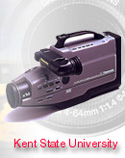

For the past several weeks, you’ve been editing video and audio in ways that will establish continuity and communicate a message. Special effects and titles add the finishing touch to your video message.
One way to add special effects to your video is to introduce different kinds of transitions between the shots. In your work for this class, you have used the basic transition—the cut, or instantaneous change—to go from one shot to the next. Other important transitions are the dissolve, in which one picture blends gradually into the next, and the wipe, in which a line or shape moves across the screen wiping the old picture off and the new picture on. Find out more about these transitions in your first reading for today:
Edit Suite: Transition Tricks
Reprinted from Videomaker Magazine
You’ll notice that the author uses some technical language to describe equipment in the section called "Everybody With Me?" If you’re not "with him" in this particular section, don’t worry about it; we aren’t using that kind of equipment in this class. But be sure to pay attention to his descriptions of different kinds of transitions and when and why to use them.
The Adobe Premiere program has lots of transitions you can use. In order to make them work:
put one video clip on Video Track 1a and the next video clip on Video Track 1b, overlapping the ends a little
open the Transitions Window
select the transition you want
drag it onto the Transitions Track between the two video clips.
(If you have a little extra time in class and want to try this out, just let me know.)
Another way to add special effects is to change the appearance of the video clips themselves by changing their color, contrast, speed, etc. The Adobe Premiere program call these changes "filters," and you can access them easily:
Click on a clip to select it.
Chose Clip> Filters.
Choose the filter you want from the box and click Add to apply the filter to the clip.
(Once again, let me know if you’d like me to help you give this a try.)
Titles and credits give your program a finished, professional look. Your second reading for this week presents some rules of thumb for creating titles that help to communicate a program’s message:
Edit Suite: You’re Entitled!
Reprinted from Videomaker Magazine
As you read this article, it will help to know that the abbreviation NTSC is a reference to the technical standard for creating television pictures in this country. Television screens work differently from computer screens, so graphics and titles that are created on a computer can sometimes change appearance drastically when they are played back on a television (NTSC) monitor.
If you enjoyed reading these articles, you might like to visit Videomaker Magazine's Web site, where you can read more articles, order merchandise, or subscribe to the magazine.

Home Page | Assignments | Syllabus | Instructor | JMC Web Site